
Frisia is a cross-border cultural region in Northwestern Europe. Stretching along the Wadden Sea, it encompasses the north of the Netherlands and parts of northwestern Germany. Wider definitions of ‘Frisia’ may include the island of Rem and the other Danish Wadden Sea Islands. The region is traditionally inhabited by the Frisians, a West Germanic ethnic group.
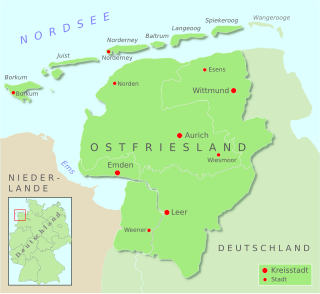
East Frisia or East Friesland is a historic region in the northwest of Lower Saxony, Germany. It is primarily located on the western half of the East Frisian peninsula, to the east of West Frisia and to the west of Landkreis Friesland.

Aurich is a town in the East Frisian region of Lower Saxony, Germany. It is the capital of the district of Aurich and is the second largest City in East Frisia, both in population, after Emden, and in area, after Wittmund.

Wittmund is a town and capital of the district of Wittmund, in Lower Saxony, Germany.
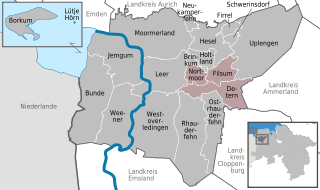
Jümme is a collective municipality (Samtgemeinde) in the district of Leer in the German state of Lower Saxony. It is named after the River Jümme which flows through all three constituent communities. It has an area of 82.34 km2 and a population of 6,421. It is situated in the region of East Frisia. Along with the Samtgemeinde of Hesel, it is one of two in the district. It was formed in the wake of local government reform in 1973. Filsum serves as the administrative centre.

Bunde is a municipal district in East Frisia, in Lower Saxony, Germany, about 20 km (12 mi) south of Emden, Germany, and 50 km (30 mi) east of Groningen, Netherlands. It lies on the southern tip of the Dollart, a bay of the North Sea between Germany and the Netherlands, and has a land border with the Netherlands.
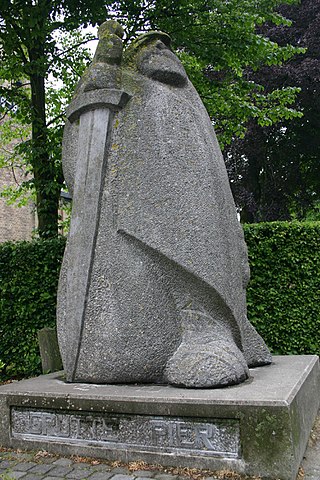
Frisia is a small region in the north of the modern day country known as the Netherlands. In the Iron Age, the ancestors of the modern Frisians first migrated south out of modern day Scandinavia to the south west where they began to settle along the coast. The archeological record goes all the way back to the Neolithic era, however, the first written sources for Frisian history come from Roman records, like Tacitus' account of an unsuccessful Frisian attack on a Roman fort. Frisia would go on to distinguish itself culturally from other Germanic peoples but remained recognizably Germanic nonetheless. In the Early Medieval era, Frisians took the seas with well crafted ships to perform trade and to raid other ports, cities, and towns in other parts of Europe. For most of its modern history, Frisia, or Frysland, has been under the control of the Netherlands but today their language is co-official with Dutch at the provincial level. Frisian is the most closely related language to English aside from Scots.

Rudolf Christian of Ostfriesland, Count of East Frisia, was count of East Frisia, and the second son of Enno III, Count of East Frisia and Anna of Holstein-Gottorp. During his reign, foreign troops participating in the Thirty Years' War began retreating into and quartering in East Frisia. Also during his reign, fen exploitation in East Frisia begins.
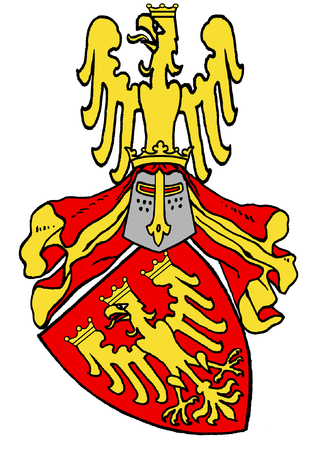
The tom Brok family were a powerful East Frisian line of chieftains, originally from the Norderland on the North Sea coast of Germany. From the second half of the 14th century, the tom Broks tried to gain control of East Frisia over the other chieftain families. The line of tom Brok died out in 1435.

The Emsigerland, or Emderland was a historic region on the western edge of East Frisia by the Wadden Sea, which covered a wide area around the town of Emden. The Emsigerland borders in the north on the Federgau, in the northeast on the Brokmerland in the east on the Moormerland and in the south on the Rheiderland.
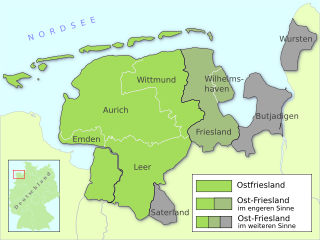
East Frisia is a collective term for all traditionally Frisian areas in Lower Saxony, Germany, which are primarily located on a peninsula between the Dollart and the Jade Bight. Along with West Frisia and North Frisia, it is one of the most commonly used subdivisions of Frisia.

Juliana of Hesse-Darmstadt was the wife of Count Ulrich II of East Frisia and was regent for her minor son Enno Louis from 1648 to 1651. Her parents were Landgrave Louis V of Hesse-Darmstadt and Magdalene of Brandenburg, daughter of Elector John George von Brandenburg.
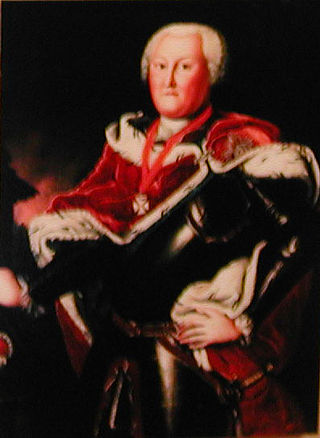
Charles Edzard was the last prince of East Frisia. He ruled from 12 June 1734 until his death.
Uko Fockena was an East Frisian chieftain of Moormerland and Emsigerland.
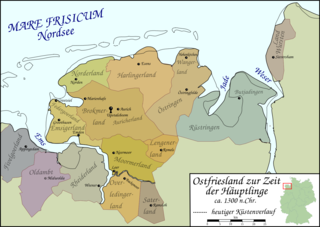
The East Frisian chieftains assumed positions of power in East Frisia during the course of the 14th century, after the force of the old, egalitarian constitution from the time of Frisian Freedom had markedly waned.
The Saxon feud was a military conflict in the years 1514–1517 between the East Frisian Count Edzard I, 'West Frisian' rebels, the city of Groningen, and Charles II, Duke of Guelders on the one hand and the Imperial Frisian hereditary governor George, Duke of Saxony – replaced by Charles V of Habsburg in 1515 – and 24 German princes. The war took place predominantly on East Frisian soil and destroyed large parts of the region.
The Appeal War was a conflict between Prince George Albert of East Frisia and the Estates of East Frisia about the authority to raise taxes, so properly speaking, it should be classified as a civil war. It was named after Heinrich Bernhard von dem Appelle. Heinrich Bernard was one of the leaders of the rebellious faction, who were called the renitents. He owned the Groß Midlum manor in Krummhörn and was the administrator of the chamber of knights in the Estates of East Frisia.

Uphusen is a village in Lower Saxony, Germany. The East Frisian village is currently a borough of the city of Emden together with Marienwehr.
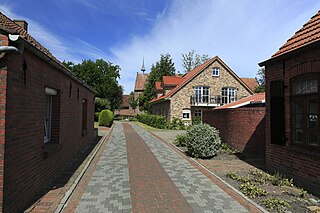
Visquard is a village in the region of East Frisia, in Lower Saxony, Germany. It is part of the municipality of Krummhörn. The village is located to the north of Pewsum and to the south of Greetsiel.

With more than 90 important organs from six centuries, the Organ landscape East Frisia is one of the richest organ landscapes in the world. The term organ landscape alone refers to the historically determined regional characteristics of the organs. 60 of the East Frisian organs date from before 1850. In addition, there are 15 historical Prospekt, behind which new Werke are installed. While Dutch organ building was influential for East Frisia in the 15th and 16th centuries, influences from Hamburg and Westphalia were added in the 17th and 18th centuries. East Frisian organ building in the 19th century was conservative until around 1870 and created instruments according to Baroque building principles. As relatively few new organs were built between 1870 and 1950, many historical instruments were preserved. Almost all of the original instruments have been restored in an exemplary manner over the last 50 years, bringing them back to their original sound and providing impetus for restoration practice and organ building worldwide. In recent decades, the public has become increasingly aware of the value of these instruments and the organ landscape of East Frisia has been made accessible to organ builders and organists from all over the world, as well as to the general public.

















